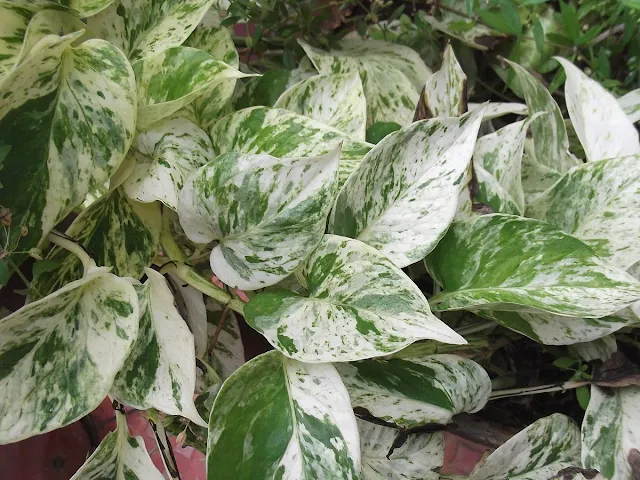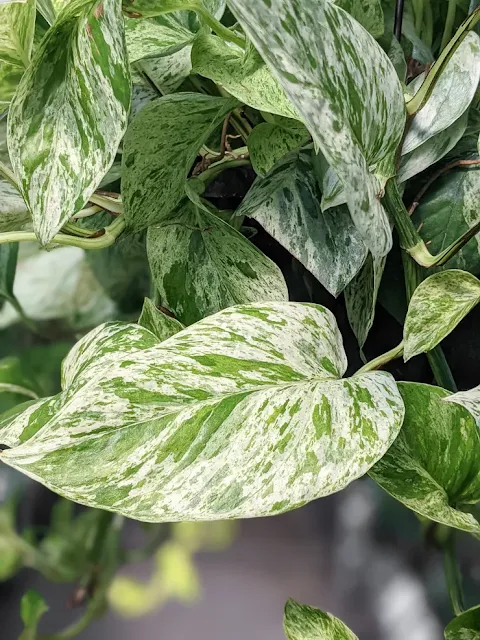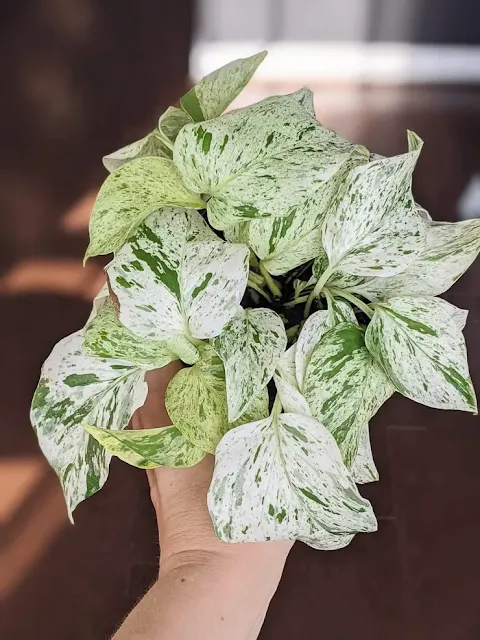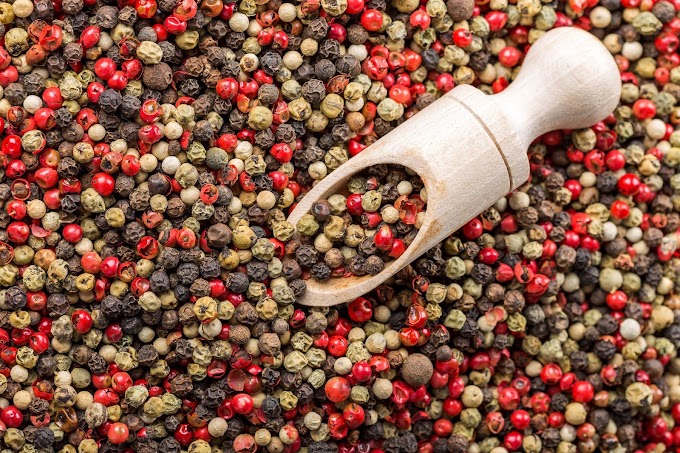 |
| Marble Queen Pothos |
If you're a plant lover, chances are you've heard of the Marble Queen Pothos plant. With its stunning green and white variegated leaves, it's easy to see why this plant has become a popular choice for plant enthusiasts.
However, caring for a Marble Queen Pothos can be tricky, especially if you're new to plant care. That's why we've put together this comprehensive guide on how to care for your Marble Queen Pothos plant and keep it thriving for years to come.
Origins and Description
The Marble Queen Pothos, also known by its scientific name Epipremnum aureum, is a cultivar of the Pothos family. This plant is native to French Polynesia, the Solomon Islands, and Southeast Asia. The Marble Queen Pothos is a climber, which means that it has a tendency to grow upwards and can reach impressive heights of up to 8 feet. Its leaves are oval-shaped, waxy, and have a striking variegation of white and green that make it stand out from other Pothos varieties.
Marble Queen Pothos Scientific Name
The scientific name for Marble Queen pothos is Epipremnum aureum 'Marble Queen'. Epipremnum aureum is the species name for all pothos plants, including Marble Queen pothos. 'Marble Queen' is the cultivar name, which refers to the specific variety of Epipremnum aureum that has variegated leaves with white and green streaks.
Health Benefits
Apart from its aesthetic appeal, the Marble Queen Pothos has several potential health benefits. This plant has been shown to be an effective air purifier and can remove toxins such as formaldehyde, benzene, and xylene from the air. It can also help regulate humidity levels in the home, which can be beneficial for individuals with respiratory issues.
Marble Queen pothos vs Snow Queen
Marble Queen pothos and Snow Queen pothos are two popular cultivars of the Epipremnum aureum family. While they share many similarities, there are some distinct differences between the two that are worth exploring.
Appearance
One of the most significant differences between Marble Queen pothos and Snow Queen pothos is their appearance. Marble Queen pothos has variegated leaves that are predominantly white with green streaks, whereas Snow Queen pothos has leaves that are predominantly green with white streaks. This difference in coloration can make a significant impact on the overall aesthetic appeal of the plant and the ambiance it creates in the room.
Growth Habits
Both Marble Queen pothos and Snow Queen pothos are climbers that can grow up to 8 feet tall. However, their growth habits differ slightly. Marble Queen pothos tends to have more compact growth with thicker stems, while Snow Queen pothos has a more elongated growth habit with thinner stems. This difference in growth habit can affect the pruning and training required to maintain the plant's desired shape and size.
Light Requirements
Both Marble Queen pothos and Snow Queen pothos prefer bright, indirect light. However, Snow Queen pothos is more tolerant of lower light conditions and can still thrive in areas with less natural light. Marble Queen pothos, on the other hand, may experience leaf burn if exposed to direct sunlight for extended periods. Therefore, it is best to keep it in a location where it can receive bright, indirect light.
Watering and Soil Requirements
Marble Queen pothos and Snow Queen pothos have similar watering and soil requirements. Both prefer well-draining soil that is rich in organic matter. They also prefer consistent moisture but can be susceptible to root rot if overwatered. It is recommended to water both plants when the top inch of soil feels dry to the touch.
Propagation
Both Marble Queen pothos and Snow Queen pothos are easy to propagate through stem cuttings. The process involves taking a stem cutting with at least two to three leaves and a node, which is where the roots will emerge. The stem cutting can then be rooted in water or soil.
Marble Queen pothos and Snow Queen pothos share many similarities, there are some notable differences between the two. Understanding these differences can help you choose the right plant for your space and care for it properly to ensure it thrives.
Choosing the Right Pot and Soil
The first step in caring for your Marble Queen Pothos plant is to choose the right pot and soil. When selecting a pot, choose one that is slightly larger than the current pot your plant is in, as Marble Queen Pothos plants like to be root-bound. It's also important to choose a pot with good drainage holes to prevent water from building up in the bottom of the pot.
When it comes to soil, Marble Queen Pothos plants prefer a well-draining soil mix that is rich in organic matter. A good soil mix for Marble Queen Pothos plants should contain a mixture of peat moss, perlite, and vermiculite. This type of soil mix will allow for proper drainage while also retaining enough moisture for the plant's roots.
Watering Your Marble Queen Pothos Plant
Watering is one of the most important aspects of caring for a Marble Queen Pothos plant. These plants prefer to be kept on the drier side, so it's important not to overwater them. A good rule of thumb is to allow the top inch of soil to dry out before watering your plant again.
When watering your Marble Queen Pothos, it's important to water thoroughly and evenly. This means watering until water begins to flow out of the drainage holes in the bottom of the pot. Be sure to empty any excess water from the saucer underneath the pot to prevent root rot.
Lighting Requirements
Marble Queen Pothos plants prefer bright, indirect light. Direct sunlight can scorch the leaves, while too little light can cause the plant to become leggy and thin. If your Marble Queen Pothos plant is not getting enough light, it may begin to lose its variegation and the leaves may turn completely green.
If you're growing your Marble Queen Pothos indoors, place it near a window that receives bright, indirect light. If you're growing your plant outdoors, choose a location that receives morning sun and afternoon shade.
Temperature and Humidity Requirements
Marble Queen Pothos plants prefer temperatures between 60-80°F (15-26°C). They can tolerate slightly cooler temperatures, but should be kept away from drafts and cold windows. They also prefer moderate to high humidity levels, so it's important to mist your plant regularly or place it near a humidifier.
Fertilizing Your Marble Queen Pothos Plant
Fertilizing your Marble Queen Pothos plant is important to keep it healthy and thriving. Use a balanced, water-soluble fertilizer once a month during the growing season (spring and summer). Be sure to follow the instructions on the fertilizer package, as over-fertilizing can cause damage to the plant.
Pruning Your Marble Queen Pothos Plant
Pruning is an important part of Marble Queen Pothos plant care. Regular pruning will keep your plant looking full and healthy, while also preventing it from becoming too leggy. When pruning, use clean, sharp scissors to cut the stem just above a leaf node. This will encourage new growth and prevent the plant from becoming too top-heavy.
Marble Queen Pothos Propagation
Marble Queen Pothos plants are relatively easy to propagate, making them a great choice for beginner plant propagators. The easiest way to propagate your Marble Queen Pothos plant is through stem cuttings.
To propagate your plant, simply cut a 4-6 inch stem just below a node (where a leaf is attached). Remove the lower leaves and place the cutting in a jar of water or a pot of moist soil. Keep the cutting in a warm, bright location and mist it regularly. In a few weeks, roots should begin to form and new growth will emerge.
Common Pests and Problems
Like all plants, Marble Queen Pothos plants can be susceptible to pests and problems. The most common pests that affect Marble Queen Pothos plants are mealybugs and spider mites. These pests can be treated with a mild insecticidal soap or by wiping the leaves down with a damp cloth.
Other problems that can affect Marble Queen Pothos plants include yellowing leaves, which can be a sign of overwatering or root rot. Brown, crispy leaves can be a sign of too little water or too much direct sunlight. If you notice any problems with your Marble Queen Pothos plant, be sure to take action right away to prevent further damage.
FAQs
How much light does a marble Queen pothos need?
Marble Queen pothos plants prefer bright, indirect light. They can tolerate some direct sunlight, but too much can cause their leaves to burn. Ideally, Marble Queen pothos should be placed near a window that receives bright, indirect light, such as an east-facing or north-facing window.
If the plant is placed in an area with lower light, it may grow more slowly and its variegation may become less pronounced. However, it is important to avoid placing Marble Queen pothos in direct sunlight for extended periods, as this can cause damage to the leaves.
How do you care for a queen marble pothos?
Marble Queen pothos is a relatively easy plant to care for. Here are some tips for keeping your Marble Queen pothos healthy:
Watering: Marble Queen pothos plants like to be kept evenly moist, but they don't like to sit in water. Water the plant when the top inch of soil feels dry to the touch, and be sure to empty any excess water from the saucer.
Light: Marble Queen pothos prefers bright, indirect light. Place the plant near a window that receives bright, filtered light, but avoid direct sunlight which can damage the leaves.
Temperature: Marble Queen pothos thrives in temperatures between 65°F and 85°F (18°C to 29°C). Keep the plant away from drafts, and avoid placing it near air conditioning or heating vents.
Humidity: Marble Queen pothos likes high humidity, but can tolerate normal household humidity levels. To increase humidity, you can place a humidifier near the plant, or place a tray of water near it.
Fertilizing: Feed your Marble Queen pothos with a balanced, water-soluble fertilizer once a month during the growing season (spring and summer).
Pruning: To keep your Marble Queen pothos full and bushy, pinch off the tips of the stems occasionally. You can also prune back any leggy or straggly stems.
Propagation: Marble Queen pothos can be propagated by stem cuttings. Simply cut a stem just below a node, and place it in water or moist soil. After a few weeks, roots will begin to grow and the cutting can be planted in soil.
By following these care tips, you can keep your Marble Queen pothos healthy and thriving for years to come.
Are marble Queen pothos easy to care?
Yes, Marble Queen pothos are generally considered to be an easy plant to care for. They are tolerant of a range of lighting conditions and can adapt to different levels of humidity. They also do well in a variety of temperatures, although they prefer to be kept in a relatively warm environment.
In terms of watering, Marble Queen pothos plants are not particularly demanding. They prefer to be kept evenly moist, but can tolerate a bit of drying out between waterings. As long as the plant is not overwatered or allowed to sit in water, it should do well.
One of the reasons that Marble Queen pothos is so popular among houseplant enthusiasts is that it is a fast-growing plant that can quickly fill up a space with its lush, variegated foliage. Additionally, Marble Queen pothos is a forgiving plant that can often recover from mistakes such as overwatering or exposure to direct sunlight.
Overall, if you are looking for a low-maintenance plant that can add some greenery to your home or office, Marble Queen pothos is a great choice.
Do marble pothos grow fast?
Yes, Marble Queen pothos is known for its relatively fast growth rate. This plant can quickly fill up a space with its trailing vines and lush foliage. The growth rate can vary depending on the conditions in which the plant is grown, such as the amount of light, humidity, and nutrients it receives.
Under ideal conditions, Marble Queen pothos can grow up to 2-3 feet long in a single growing season. This fast growth can make the plant an attractive option for those looking to add some greenery to their home or office quickly.
It's worth noting that Marble Queen pothos can also be pruned back to control its growth and encourage bushier growth. Pinching off the tips of the stems can help to promote branching and create a fuller, more compact plant.
Overall, if you're looking for a low-maintenance plant that can quickly fill up a space with its lush foliage, Marble Queen pothos is a great choice.
Is Marble Queen a money plant?
No, Marble Queen pothos is not a true money plant. Money plant is a common name given to a variety of plants, including Epipremnum aureum, which is also known as Devil's Ivy. While Marble Queen pothos and Devil's Ivy are both part of the same family, they are different species and have some distinct differences in their appearance and growth habits.
Marble Queen pothos is known for its variegated foliage, which features green leaves with white or cream-colored streaks. In contrast, Devil's Ivy typically has solid green leaves that are heart-shaped. Additionally, Devil's Ivy is often grown as a trailing vine, while Marble Queen pothos can be trained to grow as a bushier plant.
That being said, Marble Queen pothos is still a popular houseplant that can bring a touch of greenery to any indoor space. Its easy care requirements and fast growth make it a great option for beginners or those looking for a low-maintenance plant.
Does Marble Queen pothos purify air?
Yes, Marble Queen pothos is known for its air-purifying qualities. Like many other plants, Marble Queen pothos can help to remove harmful pollutants from the air, making it a great choice for improving indoor air quality.
Research has shown that indoor air can contain a variety of pollutants, including volatile organic compounds (VOCs) and other chemicals. These pollutants can come from a variety of sources, such as cleaning products, furniture, and electronics. Inhaling these pollutants over time can have negative health effects, such as respiratory issues and headaches.
Marble Queen pothos and other houseplants can help to remove these pollutants from the air by absorbing them through their leaves and roots. This process, known as phytoremediation, can help to improve indoor air quality and create a healthier living environment.
Additionally, Marble Queen pothos can help to increase humidity levels in a room, which can have a variety of health benefits. Higher humidity levels can help to relieve dry skin and respiratory issues, as well as reduce the risk of airborne viruses.
Overall, Marble Queen pothos is a great choice for anyone looking to improve their indoor air quality and create a healthier living space.
How do you make marble queen bushy?
If you want to make your Marble Queen pothos bushier, there are a few things you can do. Here are some tips:
Prune regularly: Pruning your Marble Queen pothos will encourage new growth and help to create a fuller, bushier plant. Use clean, sharp scissors to snip off any dead or yellowing leaves, as well as any vines that are growing too long.
Pinch back new growth: When your Marble Queen pothos begins to produce new growth, you can pinch back the tips of the stems to encourage branching. This will help to create a bushier, more compact plant.
Provide proper light: Marble Queen pothos plants need bright, indirect light to thrive. If your plant isn't getting enough light, it may become leggy and sparse. Make sure your plant is situated in a bright location, but out of direct sunlight.
Use a well-draining soil: Marble Queen pothos prefer a well-draining soil mix that allows excess water to drain away. This will help to prevent root rot and other issues that can affect the plant's growth and health.
Fertilize regularly: Marble Queen pothos benefit from regular fertilization during the growing season. Use a balanced, water-soluble fertilizer every 2-3 weeks to promote healthy growth and bushiness.
By following these tips, you can help to create a fuller, bushier Marble Queen pothos plant that will thrive in your home.
Conclusion
Marble Queen Pothos is a stunning plant that can add a touch of elegance to any indoor space. With its low maintenance and care requirements, it is an excellent choice for novice and experienced gardeners alike. By following the tips and guidelines outlined in this comprehensive plant profile, you can enjoy the beauty and benefits of this remarkable plant.
We hope using these tips in mind, you'll be well on your way to becoming a Marble Queen Pothos plant care expert!
Did you add a marble queen pothos to your home recently? Or, have you already had them before? How has been your experience with their care? Do share your experience with us by commenting below!
We would love to hear from you! Thanks and cheers!
















